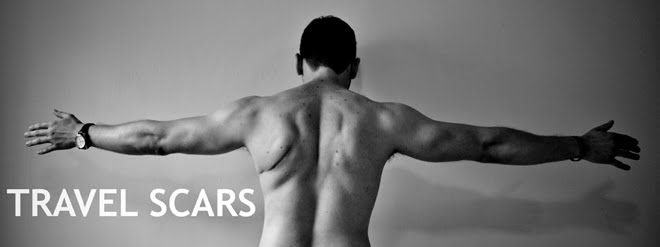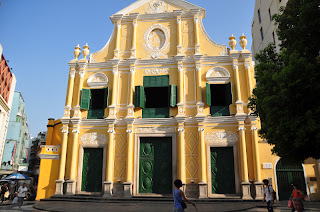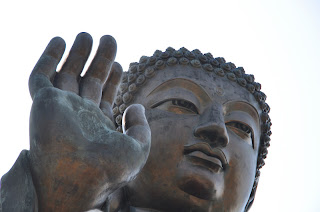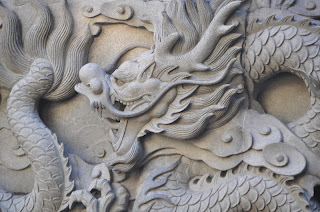Our 24-hour train ride from Hong Kong went incredibly quickly and as soon as we stepped off the train, we knew we were in a different world.
We luckily weren't completely in the dark because I had arranged to stay with a German couchsurfer and he had given us incredibly detailed directions to his place.
We hopped on a bus and managed to get off at the suggested stop with the help of the Chinese characters Kim included. After going the wrong way a few times and asking a few people for directions, we finally found Kim's flat.
He instantly welcomed us, showed us how to use his amenities and we were off to the races! Kim had to meet someone for dinner but still had enough time to show us a local market and suggest some nearby restaurants for dinner.
After our first of many Peking Duck and pork-stuffed eggplant dinners, we waited for Kim to get back from his friend's. For the rest of the evening, we discussed our respective professions and back stories; our travels and goals for China and beyond; and he attempted to teach us some words in mandarin. Good luck, mandarin is ridiculously difficult.
Kim lived in Haidian, the university district between Renmin and Peking University, working at the latter as a researcher in linguistics and their application in computer programs or something along those lines.
On our first full day in Beijing, we decided to visit Beijing's most famed monument: the Forbidden City. The Forbidden city's name stems from the fact it was off limits for 500 years and it acted as the residence of China's two final dynasties: the Ming and Qing dynasty.
We entered the city via the Gate of Heavenly Peace, with the iconic portrait of Chairman Mao on its facade. We then passed through the immense courtyard to reach the museum entrance (the city itself).
We spent several hours walking through the immense grounds, astonishingly long corridors; and sauntering to the innumerable halls, temples and palaces contained within this sprawling complex.
Every aspect of this complex was immaculate and ornate, it is no wonder these emperors were seen as gods.
Despite the grandeur of the site, the wonderful halls of Supreme Harmony and Middle Harmony; and the impressive nine Dragon Screen; a little is lost by the sheer amount of people who descend on this site at any given time. A little more forbiddeness would be nice!
I wouldn't be surprised if the Forbidden City saw hundreds of thousands of tourists per day, most of which are local tourists in their immense tour groups led by shrill-voiced, mandarin-speaking, flag-baring guides.
Approaching any of the relics contained within these wonderful halls is like trying to take pictures of the world's biggest celebrities: hundreds of cameras flashing, people pushing their way to the front with a complete disregard for others waiting in an orderly fashion.
Complete chaos!
Once we had seen the main central halls, we made our way to the eastern and western portions of the city to get away from the central areas of interest and consequently calamitous site-seeing conditions.
Upon leaving the Forbidden City, we crossed the street to Jingshan park, a park whose grounds were formed by the earth excavated to create the moat around the forbidden city. From the top of the hill you get fantastic views of the Forbidden City, although Beijing's notorious smog obstructed the clarity of our view.
We then walked around the outer wall, which brought us back to Tian'an men Square, said to be the world's largest square (90 football fields) and the infamous standoff point between the man and the government tanks during the student prodemocracy protests of 1989.
Tian'an men Square is flanked by the Forbidden City to the north, the Great Hall of the People to the west, and the Chinese National museum to the east. The square also contains the mausoleum of Mao Zedong and the granite obelisk known as the Monument to the People's Heroes.
The square was being cleaned up and decorated for the upcoming National Day on October first, being China's version of Canada Day, where seemingly the equivalent of Canada's population will descend on the square for the day's festivities.
Completely spent from our day's activities, we headed back to Kim's. Always a man on the move, Kim joined us for a quick dinner but had to leave to the train station to visit his girlfriend who lives in Xi'an. He would be gone until the middle of the following week and had graciously offered to let us stay in his apartment during his absence. We were extremely grateful and elated by his offer.
The next day we decided to do a walk suggested by Frommer's guide to China, exploring Beijing's Back Lakes.
Our walk started at Mei Lanfang Guju, home of Peking Opera star Mei Lanfang and a beautiful example of Beijing's famed siheyuan (courtyard home) and hutong (narrow and winding alley) neighborhoods that define the old city. From there we passed the former campus of Furen University and visited Prince Gong's mansion.
Built in 1777, this lavish courtyard residence was the former home of its namesake, boasting numerous pavilions, temples and even a coy pond with ducks. Luckily we had arrived early enough to avoid the influx of Chinese tourists entering.
Our next stop was wild duck island built on the beautiful Hou Hai lake. We then continued around the lake admiring the scenery and the happy young couples on tandem bicycles and paddle-boats; as well as the elderly being escorted by rickshaws.
Simply wonderful!
Our walk terminated at the impressive Drum and Bell towers providing beautiful albeit smoggy views of the surrounding hutong neibouhoods.
Being suckers for punishment, we walked up the Chinese hipster street of Gulou Dongdajie and continued on for another 45-minutes before reaching the mystical Lama Temple.
The Lama Temple is the most renown Tibetan temple outside of Tibet. The grounds were swarming with white tourists seeing as though we're all infatuated with Tibet, their struggle for freedom and self-immolations.
Although the outer architecture resembles many other Ming and Qing dynasty buildings, many elements were purely Tibetan, from their ornate and detailed Buddhist statues to Tibetan cursive banners and relics adorning the various buildings.
What was particularly interesting is that it is still an active place of worship, with scores of Buddhists burning incense for various deities. I'll find it in my heart to forgive the goofy white guy trying to emulate the actual Buddhists praying beside him, but common, show some respect!
The most impressive and surprising relic contained within this complex was the 18m statue of Buddha in the unassuming Wanfu pavilion.
Our final stop of the day was to the Temple of Heaven Park. A leisurely walk through the grounds led us to the park's dominant feature, passing competing choirs of elderly Chinese and people of all ages engaging in some sort of activity.
The Hall of Prayer for Good Harvests is the iconic building associated with the Temple of Heaven and it was a nice change from the boxy architecture of most Ming and Qing buildings around Beijing.
That night we attempted to get the same great meal of Peking duck and pork-infused eggplant but a failure to communicate properly left us duck-less.
Our tourism marathon continued on the next day with the immaculate Summer Palace. This palace acted as the Imperial Court's summer getaway and both Josh and I found it more impressive than the Forbidden. City. We spent most of the day admiring the palace's unique architecture, circling Kunming Lake and hiking up countless stairs to reach the Buddhist Temple of the Sea of Wisdom and the Buddhist Fragrance pavilion.
What I really loved about this place was that it was large enough to escape the throngs of tourists and have a little tranquility within this unrelenting capital city.
Our final stop of the day was to Beijing's Bird Nest or National Stadium, used for the 2008 Summer Olympics. We had arrived too late to enter this beautiful feat of modern architecture, but the view from the outside was still worth it. I couldn't help but wonder what this city looked like prior to the Olympics: China apparently invested 40 billion (yes you read that right) dollars to hold the games and renovate the city.
After just three days, we had seen some incredible sites and visited some awe-inspiring structures, but still the greatest of all man-made structures, arguably in the entire world, sprawled just beyond Beijing. The next few days would distance us from the Beijing zoo and bring us to the immeasurable Great Wall of China!



























































